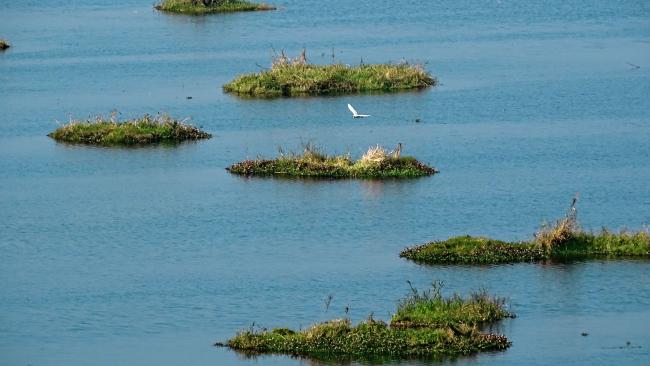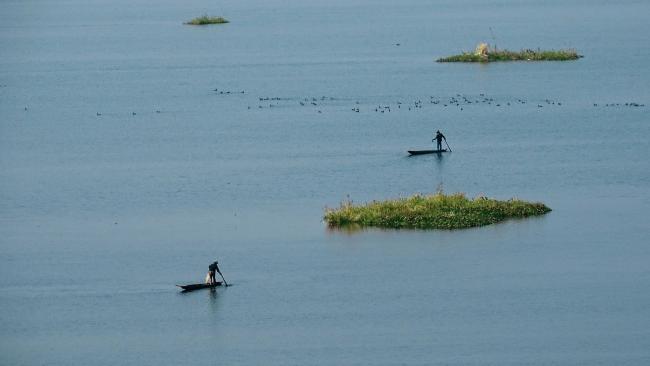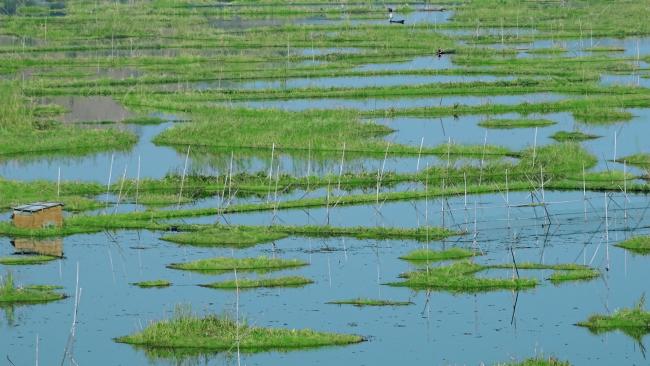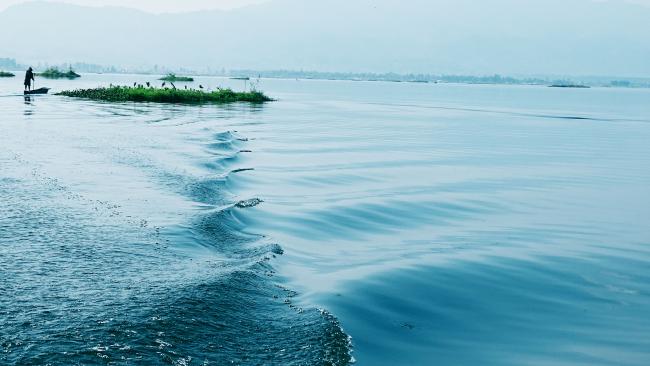
Loktak Lake
In the shadows of your footsteps many lives exist
On your nature’s bounty many lives lean
O, beloved mother Loktak
O, beloved mother Loktak
(From Ranbir Thouna’s song, Loktak)
Picture a lake where massive landmasses covered in shaggy green vegetation naturally generate over its surface. They have no base, yet still become so dense that they can bear not only the load of occupants, but the weight of an entire house.

Phumdis on Loktak Lake
Loktak Lake shines at the center of Manipur, a state in northeastern India that’s also known as “Paradise Unexplored” and the “Jewel of India.” Loktak (lok means “stream” and tak means “the end”) sits where the journey of several streams and rivers comes to an end. It is a natural treasure for Manipur and plays a significant role in the economy of the state, as Loktak is the main resource for power, irrigation, and drinking water for the entire state.
Loktak Lake is the largest fresh water body in northeastern India. The lake is speckled by phumdis: large, circular masses of intertwined vegetation, soil, and other organic matter. Phumdis are the reason Loktak Lake is known as the world’s only “floating” lake.
The largest phumdi on Loktak Lake covers over 40 square kilometers. In 1977 it was designated Keibul Lamjao National Park, and it remains the only floating park in the world. The lake is the only body of water in India that was included on the BBC’s list of the world’s 14 most beautiful bodies of water.
Athaphum Fishing: A Major Threat
Although using phumdis for fishing is a traditional practice in Manipur, it has now become a major threat to Loktak’s sustainability. Decomposition of the phumdis disturbs water levels and decreases water quality, and their proliferation has reduced the overall water-holding capacity of the lake and reduced its aesthetic value.
Athaphum fishing essentially involves two phases. The first phase is called phum thaba (phum refers to the phumdis and thaba means “laying out”) and centers around building a place to fish. Large circular phums (2.5 meters wide and 1 meter thick) are prepared and kept afloat in the lake. Long strips of cut phumdi (2 to 3 meters wide and 0.5 to 1 meter thick) are transported, creating large enclosed circles with circumferences of 200 to 250 meters.

Fishermen on Loktak Lake
Thin cut pieces of phumdis and/or other aquatic plants, such as water hyacinth and Salvinia, are added within the phum enclosures. Sometimes soaked rice bran, oil cakes, cow dung, rotten coconuts, and waste from local liquor breweries and other food sources are used as bait to attract fish.
The second phase is the harvest phase, called phum namba. It involves a team of about 20 fishermen and fisherwomen on six or seven canoes working for about six to eight hours. First, the circular phum is surrounded with a net called a hapa. It touches the lake bed in a way that leaves no room for the fish to escape. The floating plants within the athaphums are gradually removed and the entire area is churned with bamboo poles. The suspended silt and organic matter brought up from the bottom soon deoxygenates the water. Fish then come to the surface of the water for oxygen and the fishermen can easily catch them with dip nets.

Athaphum and phum shang
Loss of Biodiversity
People construct their huts on one edge of their athaphum. Known as phum shang, these seemingly floating domiciles are made by accumulating hydrophilic plants, wood, bamboo, plastic rope, and other materials that block sunlight. The lower portion of the floating hut/landmass eventually decomposes and sinks to the bottom of the lake, releasing toxic gases such as hydrogen sulfide and methane.

Waves on Loktak Lake
These gases dissolve oxygen and endanger the survival of aquatic plants and animals. The layer above this decomposed material is a dead water zone, called a hypolimnion. Above the hypolimnion, there is a thin layer termed the epilimnion that is the only place where sunlight can penetrate, allowing aquatic plants to grow and local fish to survive.
The decomposition of phum shang is increasing every day, polluting the lake and posing a threat to biodiversity.
The construction of hydraulic structures, particularly the Ithai Barrage, is also leading to a decline in the biodiversity of Loktak Lake. The Ithai Barrage is a dam along the Manipur River, and it has already blocked the migratory pathways of the riverine fish. Today, many species of fish can only be seen during the rainy season, when floods or short openings of the Ithai Barrage allow them to enter the lake.
Sangai: The Dancing Deer
The changing conditions at Loktak Lake have an adverse effect on the sangai, the brow-antlered deer for which the Manipur region is known. Rucervus eldii eldii is one of the three subspecies of Eld’s Deer found only in Southeast Asia, and is specially adapted to the phumdi habitat. The deer have divided hooves, and their pasterns are greatly elongated, unlike those of other related deer species. These features allow the animal to easily walk over the floating landmass of Keibul Lamjao National Park, which is a central habitat.
The beauty of the sangai lies in their unique posture and behavior while running. They stop suddenly to look backward, as if it is waiting for someone, even if running for their lives. The name sangai can be broken down this way: sa means “animal” and ngai means “the awaiting.”
Traditional folk tales tell the story of a lover who once captured this beautiful deer as a gift for his beloved. When he returned from his quest to find the deer, he found that she had already married a king. Heartbroken, her lover released the deer in the southern area of Loktak Lake. Like the lover who once possessed it, the deer is constantly looking over its shoulder, pining for its lost love.
Sangai deer are highly endangered. Prior to 1891, they were protected by order of the royal family; any man who killed a sangai had his hands chopped off. In 1951, the government of Manipur declared that this species had become extinct as a result of hunting and the thinning of the phumdis. However, a survey in 1953 discovered a few survivors in a small, marshy part of the floating park. In response, the government of Manipur designated all of Loktak Lake a sanctuary and shooting wildlife was prohibited.
The declaration of Keibul Lamjao as a national park elevated the population of Sangai from 14 in 1975 to 162 in 2000. They are now protected against poaching, thinning of the phumdis, and even danger from other wild animals.
Photos are copyright protected and may not be reproduced without permission. Copyright information for the photos is as follows: (1) Loktak Lake, photo courtesy of Mohit Raj, (2) Phumdis on Loktak Lake, photo courtesy of Mohit Raj, (3) Fishermen on Loktak Lake, photo courtesy of Mohit Raj, (4) Fishermen and phumdis, photo courtesy of Mohit Raj, (5) Waves on Loktak Lake, photo courtesy of Mohit Raj.